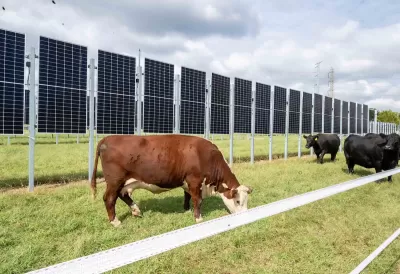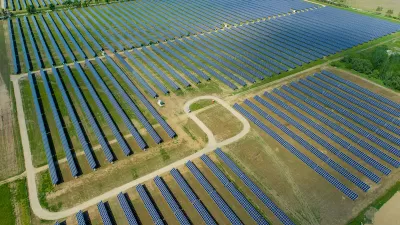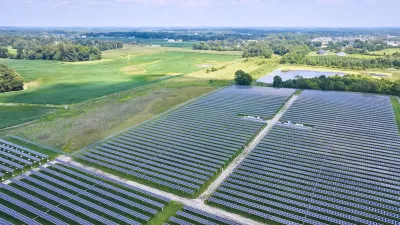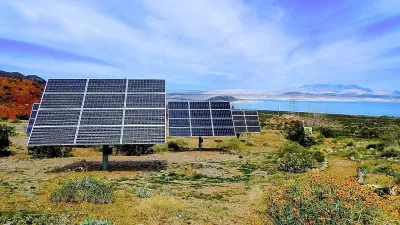A Rutgers University-New Brunswick demonstration farm will evaluate solar array designs to understand how they can best support grazing and agriculture on the same site.

A new research and demonstration project at Rutgers University-New Brunswick combining solar energy production with livestock grazing could help researchers understand how the design of solar installations can facilitate agriculture and ranching on the same sites to prevent the loss of productive farmland to solar farms.
As Kitta MacPherson explains in a Rutgers press release, “The installation on College Farm Road on the George H. Cook campus will allow researchers to investigate how the design affects grazing strategies for beef cattle and ease of hay harvesting. Scientists also will assess whether certain crops fare better in New Jersey’s climate using an agrivoltaics system, compared with crops produced in other regions of the United States employing agrivoltaics.”
Unlike many solar arrays, the Rutgers installation spaces panels far enough apart to let grass grow between rows and provide enough space for cows to graze. According to Rutgers Agrivoltaic Program Lead David Specca, “Our approach emphasizes food production and considers the generated electricity as a low-risk and supplemental income for farmers.” The project could help New Jersey get closer to reaching its renewable energy goals while preserving farmland.
Earlier this year, Ohio state officials gave the go-ahead to a 6,000-acre agrivoltaic project that will combine solar energy production with sheep ranching and agriculture.
FULL STORY: Cows and Solar Panels? In a New Jersey First, Project Melds Farming With Electricity Generation

Study: Maui’s Plan to Convert Vacation Rentals to Long-Term Housing Could Cause Nearly $1 Billion Economic Loss
The plan would reduce visitor accommodation by 25,% resulting in 1,900 jobs lost.

North Texas Transit Leaders Tout Benefits of TOD for Growing Region
At a summit focused on transit-oriented development, policymakers discussed how North Texas’ expanded light rail system can serve as a tool for economic growth.

Using Old Oil and Gas Wells for Green Energy Storage
Penn State researchers have found that repurposing abandoned oil and gas wells for geothermal-assisted compressed-air energy storage can boost efficiency, reduce environmental risks, and support clean energy and job transitions.

Planting Relief: Tackling Las Vegas Heat One Tree at a Time
Nevada Plants, a Las Vegas-based nonprofit, is combating the city’s extreme urban heat by giving away trees to residents in underserved neighborhoods, promoting shade, sustainability, and community health.

How Madison’s Tree Planting Efforts Are Growing a Healthier Community
Madison’s annual tree planting initiative is enhancing environmental resilience, public health, and community livability by adding 1,400 carefully selected trees citywide, with strong community and institutional support for urban forestry.

Texas State Bills Could Kill Transit Funding in Dallas, Austin
State lawmakers could pull funding from the state’s largest transit agency and the ambitious Project Connect, a voter-approved transit project in Austin.
Urban Design for Planners 1: Software Tools
This six-course series explores essential urban design concepts using open source software and equips planners with the tools they need to participate fully in the urban design process.
Planning for Universal Design
Learn the tools for implementing Universal Design in planning regulations.
Ascent Environmental
Borough of Carlisle
Institute for Housing and Urban Development Studies (IHS)
City of Grandview
Harvard GSD Executive Education
Toledo-Lucas County Plan Commissions
Salt Lake City
NYU Wagner Graduate School of Public Service





























